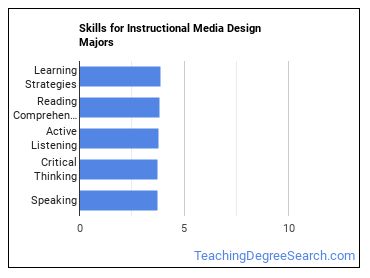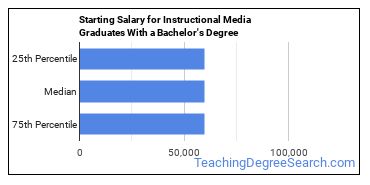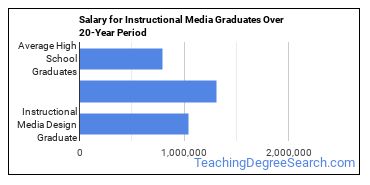Instructional Media Design
Featured schools near , edit
Types of Degrees Instructional Media Design Majors Are Getting
The following table lists how many instructional media design graduations there were in 2020-2021 for each degree level.
| Education Level | Number of Grads |
|---|---|
| Master’s Degree | 6,799 |
| Graduate Certificate | 1,383 |
| Doctor’s Degree | 205 |
| Bachelor’s Degree | 107 |
| Basic Certificate | 84 |
| Associate Degree | 77 |
| Undergraduate Certificate | 40 |
What Instructional Media Design Majors Need to Know
O*NET surveyed people in occupations related to instructional media and asked them what knowledge areas, skills, and abilities were important for their jobs. The responses were rated on a scale of 1 to 5 with 5 being most important.
Knowledge Areas for Instructional Media Majors
According to O*NET survey takers, a major in instructional media should prepare you for careers in which you will need to be knowledgeable in the following areas:

- Education and Training - Knowledge of principles and methods for curriculum and training design, teaching and instruction for individuals and groups, and the measurement of training effects.
- English Language - Knowledge of the structure and content of the English language including the meaning and spelling of words, rules of composition, and grammar.
- Computers and Electronics - Knowledge of circuit boards, processors, chips, electronic equipment, and computer hardware and software, including applications and programming.
- Customer and Personal Service - Knowledge of principles and processes for providing customer and personal services. This includes customer needs assessment, meeting quality standards for services, and evaluation of customer satisfaction.
- Communications and Media - Knowledge of media production, communication, and dissemination techniques and methods. This includes alternative ways to inform and entertain via written, oral, and visual media.
Skills for Instructional Media Majors
The following list of skills has been highlighted as some of the most essential for careers related to instructional media:

- Learning Strategies - Selecting and using training/instructional methods and procedures appropriate for the situation when learning or teaching new things.
- Reading Comprehension - Understanding written sentences and paragraphs in work related documents.
- Active Listening - Giving full attention to what other people are saying, taking time to understand the points being made, asking questions as appropriate, and not interrupting at inappropriate times.
- Critical Thinking - Using logic and reasoning to identify the strengths and weaknesses of alternative solutions, conclusions or approaches to problems.
- Speaking - Talking to others to convey information effectively.
Abilities for Instructional Media Majors
Instructional Media majors often go into careers where the following abilities are vital:

- Oral Expression - The ability to communicate information and ideas in speaking so others will understand.
- Oral Comprehension - The ability to listen to and understand information and ideas presented through spoken words and sentences.
- Written Comprehension - The ability to read and understand information and ideas presented in writing.
- Written Expression - The ability to communicate information and ideas in writing so others will understand.
- Speech Recognition - The ability to identify and understand the speech of another person.
What Can You Do With a Instructional Media Design Major?
Below is a list of occupations associated with instructional media:
| Job Title | Job Growth Rate | Median Salary |
|---|---|---|
| Audio-Visual and Multimedia Collections Specialists | 8.8% | $49,600 |
| Instructional Coordinators | 10.5% | $64,450 |
| Instructional Designers and Technologists | 10.5% | $64,450 |
Who Is Getting a Bachelor’s Degree in Instructional Media Design?
Racial-Ethnic Diversity
At the countrywide level, the racial-ethnic distribution of instructional media majors is as follows:

| Race/Ethnicity | Number of Grads |
|---|---|
| Asian | 3 |
| Black or African American | 30 |
| Hispanic or Latino | 14 |
| White | 49 |
| International Students | 3 |
| Other Races/Ethnicities | 8 |
Geographic Diversity
Americans aren’t the only ones with an interest in Instructional Media. About 2.8% of those with this major are international students. The most popular countries for students from outside the country are:
- China
- Saudi Arabia
- South Korea
- India
- Taiwan
How Much Do Instructional Media Design Majors Make?
Bachelor’s Degree Starting Salary
According to 2019-2020 data from the U.S. Department of Education, students who graduated with a bachelor’s degree in instructional media have a median salary of $59,651 during the early years of their career. During this timeframe, most salaries fell between $59,651 (25th percentile) and $59,651 (75th percentile).

It’s important to note that just because the people reporting these salaries have a degree in instructional media, it does not mean that they are working in a job related to their degree.
Salaries According to BLS
Average salaries range from $52,270 to $67,490 (25th to 75th percentile) for careers related to instructional media. This range includes all degree levels, so you may expect those with a more advanced degree to make more while those with less advanced degrees will typically make less.
To put that into context, according to BLS data from the first quarter of 2020, the typical high school graduate makes between $30,000 and $57,900 a year (25th through 75th percentile). The average person with a bachelor’s degree (any field) makes between $45,600 and $99,000. Advanced degree holders make the most with salaries between $55,600 and $125,400.
Amount of Education Required for Careers Related to Instructional Media Design
Some careers associated with instructional media require an advanced degree while some may not even require a bachelor’s. In general, the more advanced your degree the more career options will open up to you. However, there is significant time and money that needs to be invested into your education so weigh the pros and cons.
Find out what the typical degree level is for instructional media careers below.

| Education Level | Percentage of Workers |
|---|---|
| High School Diploma - or the equivalent (for example, GED) | 1.4% |
| Post-Secondary Certificate - awarded for training completed after high school (for example, in agriculture or natural resources, computer services, personal or culinary services, engineering technologies, healthcare, construction trades, mechanic and repair technologies, or precision production) | 4.9% |
| Some College Courses | 4.8% |
| Associate’s Degree (or other 2-year degree) | 0.5% |
| Bachelor’s Degree | 28.2% |
| Post-Baccalaureate Certificate - awarded for completion of an organized program of study; designed for people who have completed a Baccalaureate degree but do not meet the requirements of academic degrees carrying the title of Master. | 1.5% |
| Master’s Degree | 47.9% |
| Post-Master’s Certificate - awarded for completion of an organized program of study; designed for people who have completed a Master’s degree but do not meet the requirements of academic degrees at the doctoral level. | 4.3% |
| First Professional Degree - awarded for completion of a program that: requires at least 2 years of college work before entrance into the program, includes a total of at least 6 academic years of work to complete, and provides all remaining academic requirements to begin practice in a profession. | 1.7% |
| Doctoral Degree | 4.9% |
Online Instructional Media Design Programs
In 2020-2021, 355 schools offered a instructional media program of some type. The following table lists the number of programs by degree level, along with how many schools offered online courses in the field.
| Degree Level | Colleges Offering Programs | Colleges Offering Online Classes |
|---|---|---|
| Certificate (Less Than 1 Year) | 0 | 0 |
| Certificate (1-2 years) | 3 | 0 |
| Certificate (2-4 Years) | 0 | 0 |
| Associate’s Degree | 5 | 0 |
| Bachelor’s Degree | 147 | 82 |
| Post-Baccalaureate | 0 | 0 |
| Master’s Degree | 268 | 145 |
| Post-Master’s | 40 | 0 |
| Doctor’s Degree (Research) | 38 | 11 |
| Doctor’s Degree (Professional Practice) | 1 | 0 |
| Doctor’s Degree (Other) | 0 | 0 |
Is a Degree in Instructional Media Design Worth It?
The median salary for a instructional media grad is $52,270 per year. This is based on the weighted average of the most common careers associated with the major.
This is 31% more than the average salary for an individual holding a high school degree. This adds up to a gain of about $247,400 after 20 years!

Top Ranking Lists for Instructional Media Design
Explore Major by State
Alabama
California
District of Columbia
Idaho
Kansas
Maryland
Mississippi
Nevada
New York
Oklahoma
South Carolina
Utah
West Virginia
Alaska
Colorado
Florida
Illinois
Kentucky
Massachusetts
Missouri
New Hampshire
North Carolina
Oregon
South Dakota
Vermont
Wisconsin
Majors Related to Instructional Media Design
You may also be interested in one of the following majors related to instructional media.
| Major | Number of Grads |
|---|---|
| Teacher Education Grade Specific | 110,226 |
| Educational Administration | 46,469 |
| Teacher Education Subject Specific | 43,297 |
| Special Education | 36,792 |
| General Education | 29,810 |
| Curriculum & Instruction | 19,832 |
| Student Counseling | 13,858 |
| Teaching English or French | 5,791 |
| Other Education | 4,858 |
| Teaching Assistants | 2,751 |
| Educational Assessment | 2,552 |
| Multilingual Education | 1,910 |
| Education Philosophy | 737 |
| International Education | 293 |
References
*The racial-ethnic minorities count is calculated by taking the total number of students and subtracting white students, international students, and students whose race/ethnicity was unknown. This number is then divided by the total number of students at the school to obtain the racial-ethnic minorities percentage.
- College Factual
- College Scorecard
- National Center for Education Statistics
- O*NET Online
- U.S. Bureau of Labor Statistics
- Usual Weekly Earnings of Wage and Salary Workers First Quarter 2020
- Image Credit: By Antanana under License
More about our data sources and methodologies.
Featured Schools
 Request Info
Request Info
|
Southern New Hampshire University You have goals. Southern New Hampshire University can help you get there. Whether you need a bachelor's degree to get into a career or want a master's degree to move up in your current career, SNHU has an online program for you. Find your degree from over 200 online programs. Learn More > |

